2012 RENAULT CLIO SPORT TOURER window
[x] Cancel search: windowPage 43 of 264
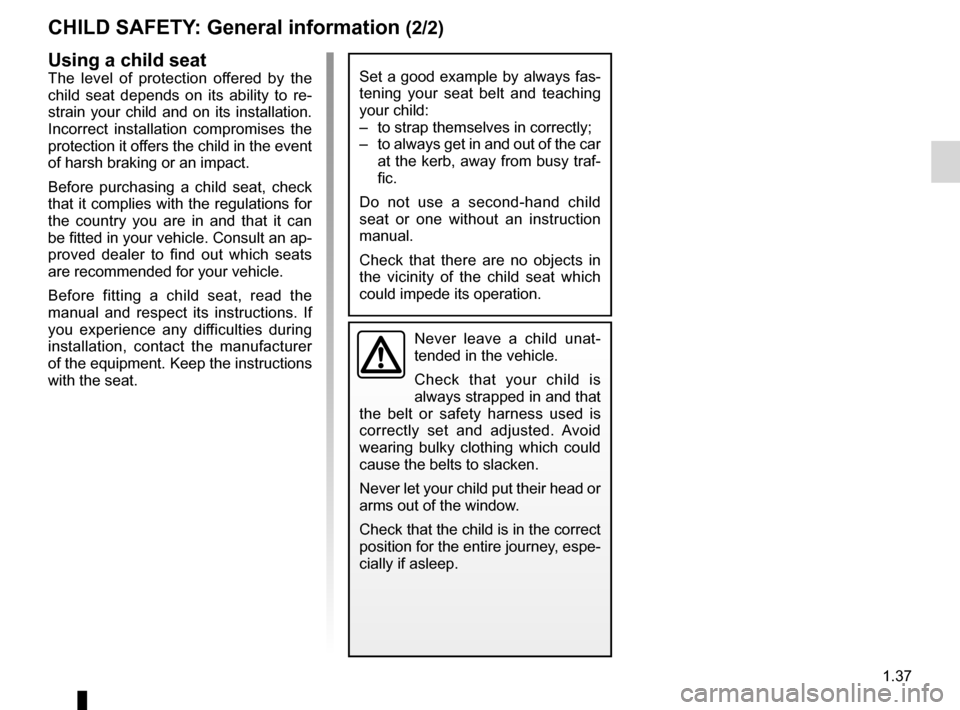
child safety............................................ (up to the end of the DU)
child restraint/seat ................................ (up to the end of the DU)
child restraint/seat ................................ (up to the end of the DU)
child restraint/seat ................................ (up to the end of the DU)
child seats ............................................. (up to the end of the DU)
transporting children ............................. (up to the end of the DU)
children ................................................. (up to the end of the DU)
JauneNoirNoir texte
1.37
ENG_UD18356_1
Sécurité enfants : généralités (X45 - H45 - L38 - X38 - \
X32 - Renault)
ENG_NU_853-8_BCSK85_Renault_1
CHILD SAFETY : General information (2/2)
Using a child seat
The level of protection offered by the
child seat depends on its ability to re -
strain your child and on its installation.
Incorrect installation compromises the
protection it offers the child in the event
of harsh braking or an impact.
Before purchasing a child seat, check
that it complies with the regulations for
the country you are in and that it can
be fitted in your vehicle. Consult an ap-
proved dealer to find out which seats
are recommended for your vehicle.
Before fitting a child seat, read the
manual and respect its instructions. If
you experience any difficulties during
installation, contact the manufacturer
of the equipment. Keep the instructions
with the seat.Set a good example by always fas-
tening your seat belt and teaching
your child:
– to strap themselves in correctly;
– to always get in and out of the car
at the kerb, away from busy traf-
fic.
Do not use a second-hand child
seat or one without an instruction
manual.
Check that there are no objects in
the vicinity of the child seat which
could impede its operation.
Never leave a child unat -
tended in the vehicle.
Check that your child is
always strapped in and that
the belt or safety harness used is
correctly set and adjusted. Avoid
wearing bulky clothing which could
cause the belts to slacken.
Never let your child put their head or
arms out of the window.
Check that the child is in the correct
position for the entire journey, espe-
cially if asleep.
Page 45 of 264
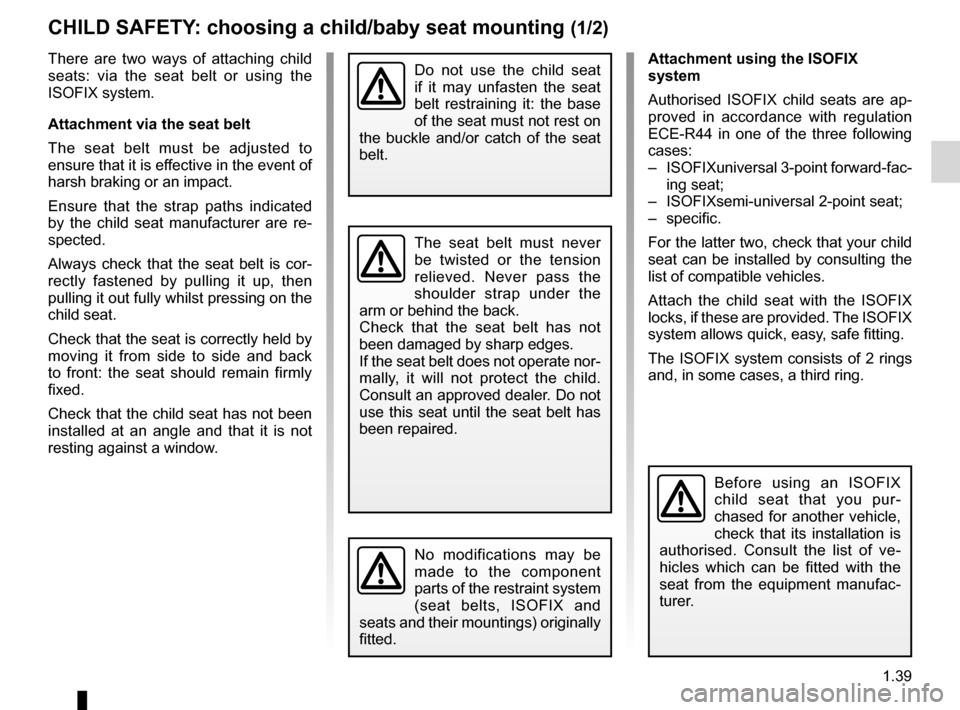
child restraint/seat ................................ (up to the end of the DU)
child restraint/seat ................................ (up to the end of the DU)
child restraint/seat ................................ (up to the end of the DU)
child safety ............................................ (up to the end of the DU)
child seats ............................................. (up to the end of the DU)
transporting children ............................. (up to the end of the DU)
Isofix ..................................................... (up to the end of the DU)
1.39
ENG_UD22283_2
Sécurité enfants : choix de la fixation du siège enfant (X85 -\
B85 - C85 - S85 - K85 - Renault)
ENG_NU_853-8_BCSK85_Renault_1
Choosing a child seat mounting
CHILD SAFETY : choosing a child/baby seat mounting (1/2)
There are two ways of attaching child
seats: via the seat belt or using the
ISOFIX system.
Attachment via the seat belt
The seat belt must be adjusted to
ensure that it is effective in the event of
harsh braking or an impact.
Ensure that the strap paths indicated
by the child seat manufacturer are re-
spected.
Always check that the seat belt is cor-
rectly fastened by pulling it up, then
pulling it out fully whilst pressing on the
child seat.
Check that the seat is correctly held by
moving it from side to side and back
to front: the seat should remain firmly
fixed.
Check that the child seat has not been
installed at an angle and that it is not
resting against a window.Do not use the child seat
if it may unfasten the seat
belt restraining it: the base
of the seat must not rest on
the buckle and/or catch of the seat
belt.
The seat belt must never
be twisted or the tension
relieved. Never pass the
shoulder strap under the
arm or behind the back.
Check that the seat belt has not
been damaged by sharp edges.
If the seat belt does not operate nor-
mally, it will not protect the child.
Consult an approved dealer. Do not
use this seat until the seat belt has
been repaired.
No modifications may be
made to the component
parts of the restraint system
(seat belts, ISOFIX and
seats and their mountings) originally
fitted.
Attachment using the ISOFIX
system
Authorised ISOFIX child seats are ap -
proved in accordance with regulation
ECE-R44 in one of the three following
cases:
– ISOFIXuniversal 3-point forward-fac-
ing seat;
– ISOFIXsemi-universal 2-point seat;
– specific.
For the latter two, check that your child
seat can be installed by consulting the
list of compatible vehicles.
Attach the child seat with the ISOFIX
locks, if these are provided. The ISOFIX
system allows quick, easy, safe fitting.
The ISOFIX system consists of 2 rings
and, in some cases, a third ring.
Before using an ISOFIX
child seat that you pur -
chased for another vehicle,
check that its installation is
authorised. Consult the list of ve -
hicles which can be fitted with the
seat from the equipment manufac -
turer.
Page 98 of 264
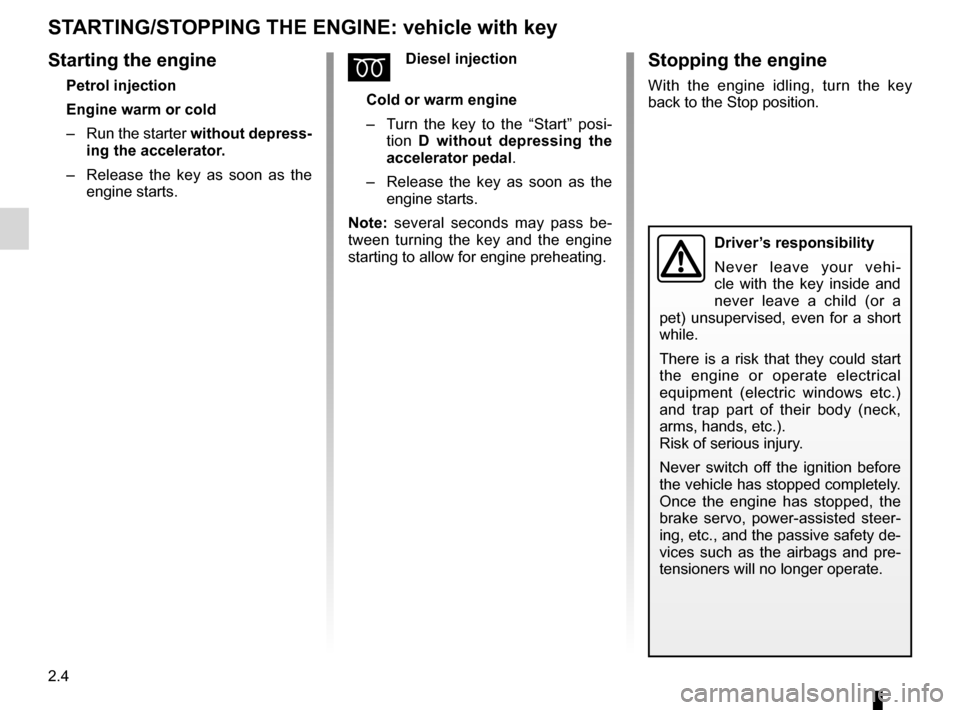
stopping the engine .............................. (up to the end of the DU)
engine start/stop button ........................ (up to the end of the DU)
driving ................................................... (up to the end of the DU)
starting the engine ................................ (up to the end of the DU)
2.4
ENG_UD10550_1
Démarrage / arrêt moteur : véhicule avec clé / télécom\
mande à radiofréquence (X85 - B85 - C85 - S85 - K85 - Renault)
ENG_NU_853-8_BCSK85_Renault_2
Starting/stopping the engine using the key
Stopping the engine
With the engine idling, turn the key
back to the Stop position.ÉDiesel injection
Cold or warm engine
– Turn the key to the “Start” posi -
tion D without depressing the
accelerator pedal .
– Release the key as soon as the
engine starts.
Note: several seconds may pass be -
tween turning the key and the engine
starting to allow for engine preheating.Starting the engine
Petrol injection
Engine warm or cold
– Run the starter without depress-
ing the accelerator.
– Release the key as soon as the
engine starts.
STARTING/STOPPING THE ENGINE: vehicle with key
Driver’s responsibility
Never leave your vehi-
cle with the key inside and
never leave a child (or a
pet) unsupervised, even for a short
while.
There is a risk that they could start
the engine or operate electrical
equipment (electric windows etc.)
and trap part of their body (neck,
arms, hands, etc.).
Risk of serious injury.
Never switch off the ignition before
the vehicle has stopped completely.
Once the engine has stopped, the
brake servo, power-assisted steer -
ing, etc., and the passive safety de-
vices such as the airbags and pre -
tensioners will no longer operate.
Page 99 of 264

stopping the engine .............................. (up to the end of the DU)
engine start/stop button ........................ (up to the end of the DU)
RENAULT card use .................................................. (up to the end of the DU)
starting the engine ................................ (up to the end of the DU)
driving ................................................... (up to the end of the DU)
child safety ............................................................. (current page)
2.5
ENG_UD26550_2
Démarrage moteur : véhicule avec carte Renault (X85 - B85 - C85 -\
S85 - K85 - Renault)
ENG_NU_853-8_BCSK85_Renault_2
Starting/stopping the engine using the RENAULT card
Starting conditions.
Follow the starting instructions on the
instrument panel 2 describing the fol -
lowing conditions:
to start, depress the brake pedal or
clutch (the pedal must be depressed
throughout starting) and press button 3.
If a gear is engaged, the vehicle may
only be started by depressing the clutch
pedal.
RENAULT card
The card must be in detection zone 1
(passenger compartment and luggage
compartment, except for some high
areas such as the sun visor, spectacle
holder, dashboard upper section, etc.)
or in card reader 4.
STARTING THE ENGINE: vehicle with RENAULT CARD (1/3)
1
2
34
Driver’s responsibility
Never leave your vehicle
with the RENAULT card
inside and never leave a
child (or a pet) unsupervised, even
for a short while.
The reason for this is that the child
may endanger himself or others
by starting the vehicle, activating
equipment such as the windows, or
locking the doors.
Risk of serious injury.
Page 101 of 264
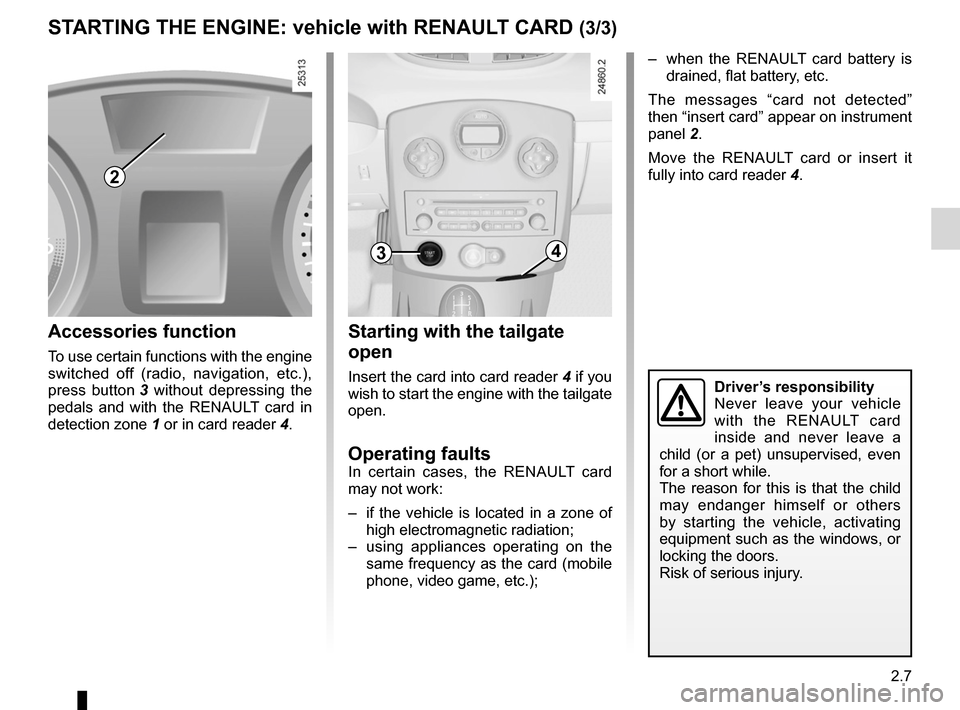
switching on the vehicle ignition ............................ (current page)
JauneNoirNoir texte
2.7
ENG_UD26550_2
Démarrage moteur : véhicule avec carte Renault (X85 - B85 - C85 -\
S85 - K85 - Renault)
ENG_NU_853-8_BCSK85_Renault_2
STARTING THE ENGINE: vehicle with RENAULT CARD (3/3)
– when the RENAULT card battery is
drained, flat battery, etc.
The messages “card not detected”
then “insert card” appear on instrument
panel 2.
Move the RENAULT card or insert it
fully into card reader 4.
Starting with the tailgate
open
Insert the card into card reader 4 if you
wish to start the engine with the tailgate
open.
Operating faultsIn certain cases, the RENAULT card
may not work:
– if the vehicle is located in a zone of
high electromagnetic radiation;
– using appliances operating on the
same frequency as the card (mobile
phone, video game, etc.);
Accessories function
To use certain functions with the engine
switched off (radio, navigation, etc.),
press button 3 without depressing the
pedals and with the RENAULT card in
detection zone 1 or in card reader 4.
2
34
Driver’s responsibility
Never leave your vehicle
with the RENAULT card
inside and never leave a
child (or a pet) unsupervised, even
for a short while.
The reason for this is that the child
may endanger himself or others
by starting the vehicle, activating
equipment such as the windows, or
locking the doors.
Risk of serious injury.
Page 102 of 264
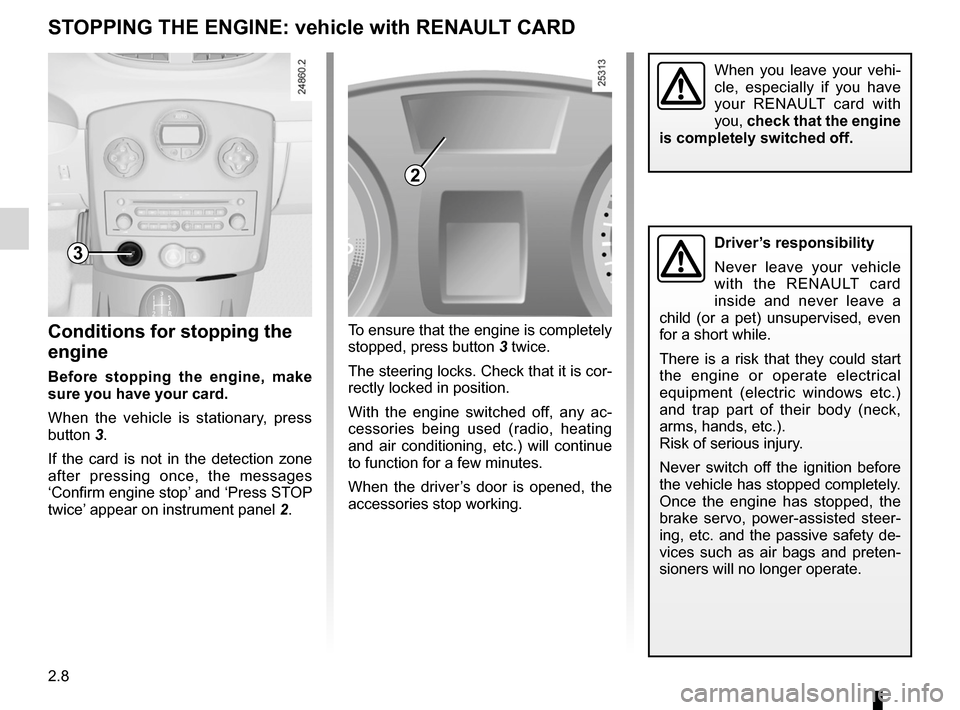
stopping the engine .............................. (up to the end of the DU)
engine start/stop button ........................ (up to the end of the DU)
RENAULT card use .................................................. (up to the end of the DU)
driving ................................................... (up to the end of the DU)
2.8
ENG_UD12574_2
Arrêt moteur : véhicule avec carte Renault (X85 - B85 - C85 - S85\
- K85 - Renault)
ENG_NU_853-8_BCSK85_Renault_2
When you leave your vehi -
cle, especially if you have
your RENAULT card with
you, check that the engine
is completely switched off.
To ensure that the engine is completely
stopped, press button 3 twice.
The steering locks. Check that it is cor-
rectly locked in position.
With the engine switched off, any ac -
cessories being used (radio, heating
and air conditioning, etc.) will continue
to function for a few minutes.
When the driver’s door is opened, the
accessories stop working.Conditions for stopping the
engine
Before stopping the engine, make
sure you have your card.
When the vehicle is stationary, press
button 3.
If the card is not in the detection zone
after pressing once, the messages
‘Confirm engine stop’ and ‘Press STOP
twice’ appear on instrument panel 2.
STOPPING THE ENGINE: vehicle with RENAULT CARD
3
2
Driver’s responsibility
Never leave your vehicle
with the RENAULT card
inside and never leave a
child (or a pet) unsupervised, even
for a short while.
There is a risk that they could start
the engine or operate electrical
equipment (electric windows etc.)
and trap part of their body (neck,
arms, hands, etc.).
Risk of serious injury.
Never switch off the ignition before
the vehicle has stopped completely.
Once the engine has stopped, the
brake servo, power-assisted steer -
ing, etc. and the passive safety de-
vices such as air bags and preten -
sioners will no longer operate.
Page 109 of 264
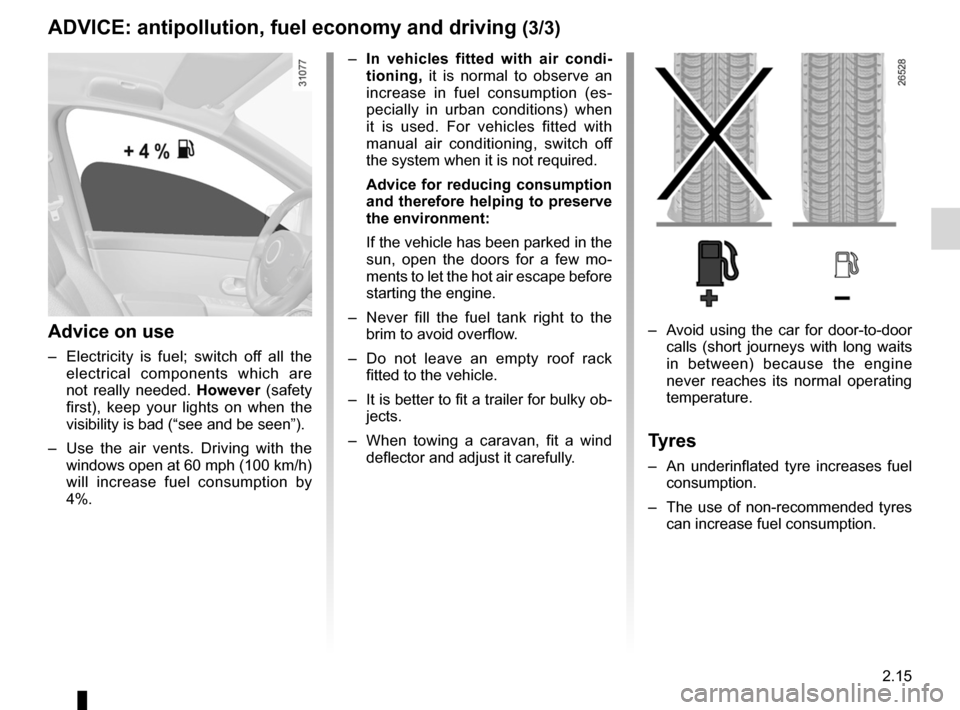
JauneNoirNoir texte
2.15
ENG_UD19886_6
Conseils antipollution, économie de carburant, conduite (X45 - H45 -\
X85 - B85 - C85 - S85 - X91 - X83 - X61 - F61 - K61 - K85 - X95 - B95 -\
D95 - J95 - R95 - L38 - X61
ENG_NU_853-8_BCSK85_Renault_2
ADVICE: antipollution, fuel economy and driving (3/3)
Advice on use
– Electricity is fuel; switch off all the
electrical components which are
not really needed. However (safety
first), keep your lights on when the
visibility is bad (“see and be seen”).
– Use the air vents. Driving with the
windows open at 60 mph (100 km/h)
will increase fuel consumption by
4%.
– Avoid using the car for door-to-door
calls (short journeys with long waits
in between) because the engine
never reaches its normal operating
temperature.
Tyres
– An underinflated tyre increases fuel
consumption.
– The use of non-recommended tyres
can increase fuel consumption.
–
In vehicles fitted with air condi -
tioning, it is normal to observe an
increase in fuel consumption (es -
pecially in urban conditions) when
it is used. For vehicles fitted with
manual air conditioning, switch off
the system when it is not required.
Advice for reducing consumption
and therefore helping to preserve
the environment:
If the vehicle has been parked in the
sun, open the doors for a few mo -
ments to let the hot air escape before
starting the engine.
– Never fill the fuel tank right to the
brim to avoid overflow.
– Do not leave an empty roof rack
fitted to the vehicle.
– It is better to fit a trailer for bulky ob-
jects.
– When towing a caravan, fit a wind
deflector and adjust it carefully.
Page 131 of 264
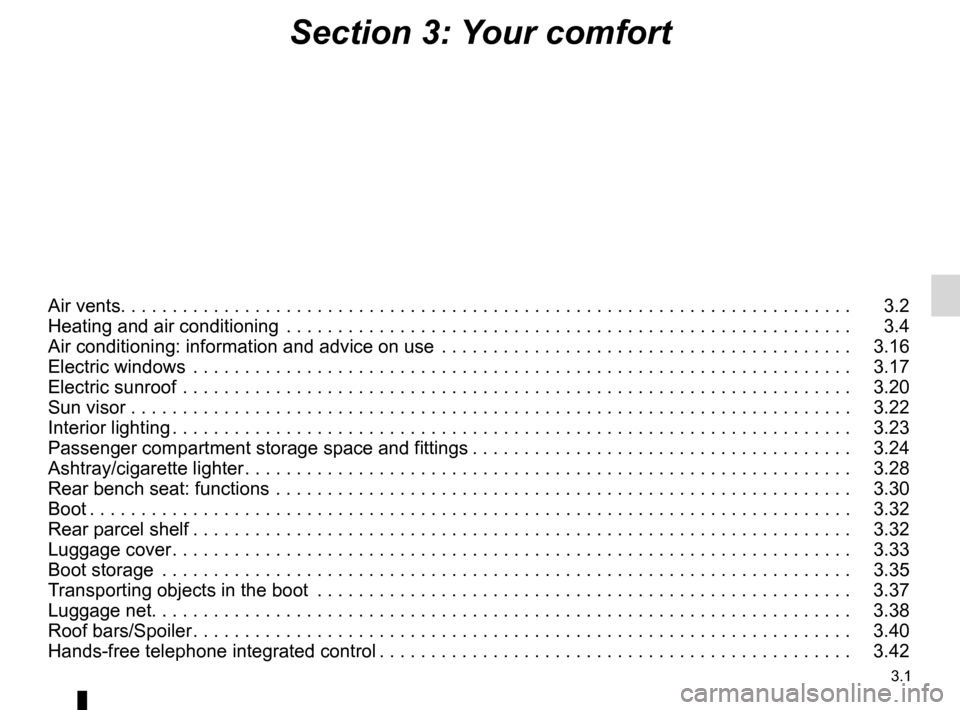
3.1
ENG_UD27581_9
Sommaire 3 (X85 - B85 - C85 - S85 - K85 - Renault)
ENG_NU_853-8_BCSK85_Renault_3
Section 3: Your comfort
Air vents. . . . . . . . . . . . . . . . . . . . . . . . . . . . . . . . . . . . \
. . . . . . . . . . . . . . . . . . . . . . . . . . . . . . . . . . . 3.2
Heating and air conditioning . . . . . . . . . . . . . . . . . . . . . . . . . . . . . . . . . . . . . . . . . . . . . . . . . . . . . . . 3.4
Air conditioning: information and advice on use . . . . . . . . . . . . . . . . . . . . . . . . . . . . . . . . . . . . . . . . 3.16
Electric windows . . . . . . . . . . . . . . . . . . . . . . . . . . . . . . . . . . . . . . . . . . . . . . . . . . . . . . . . . . . . . . . . 3.17
Electric sunroof . . . . . . . . . . . . . . . . . . . . . . . . . . . . . . . . . . . . . . . . . . . . . . . . . . . . . . . . . . . . . . . . . 3.20
Sun visor . . . . . . . . . . . . . . . . . . . . . . . . . . . . . . . . . . . . . . . . . . . . . . . . . . . . . . . . . . . . . . . . . . . . . . 3.22
Interior lighting . . . . . . . . . . . . . . . . . . . . . . . . . . . . . . . . . . . . . . . . . . . . . . . . . . . . . . . . . . . . . . . . . . 3.23
Passenger compartment storage space and fittings . . . . . . . . . . . . . . . . . . . . . . . . . . . . . . . . . . . . . 3.24
Ashtray/cigarette lighter . . . . . . . . . . . . . . . . . . . . . . . . . . . . . . . . . . . . . . . . . . . . . . . . . . . . . . . . . . . 3.28
Rear bench seat: functions . . . . . . . . . . . . . . . . . . . . . . . . . . . . . . . . . . . . . . . . . . . . . . . . . . . . . . . . 3.30
Boot . . . . . . . . . . . . . . . . . . . . . . . . . . . . . . . . . . . . . . . . . . . . . . . . . . . . . . . . . . . . . . . . . . . . . . . . . . 3.32
Rear parcel shelf . . . . . . . . . . . . . . . . . . . . . . . . . . . . . . . . . . . . . . . . . . . . . . . . . . . . . . . . . . . . . . . . 3.32
Luggage cover . . . . . . . . . . . . . . . . . . . . . . . . . . . . . . . . . . . . . . . . . . . . . . . . . . . . . . . . . . . . . . . . . . 3.33
Boot storage . . . . . . . . . . . . . . . . . . . . . . . . . . . . . . . . . . . . . . . . . . . . . . . . . . . . . . . . . . . . . . . . . . . 3.35
Transporting objects in the boot . . . . . . . . . . . . . . . . . . . . . . . . . . . . . . . . . . . . . . . . . . . . . . . . . . . . 3.37
Luggage net . . . . . . . . . . . . . . . . . . . . . . . . . . . . . . . . . . . . \
. . . . . . . . . . . . . . . . . . . . . . . . . . . . . . . . 3.38
Roof bars/Spoiler . . . . . . . . . . . . . . . . . . . . . . . . . . . . . . . . . . . . . . . . . . . . . . . . . . . . . . . . . . . . . . . . 3.40
Hands-free telephone integrated control . . . . . . . . . . . . . . . . . . . . . . . . . . . . . . . . . . . . . . . . . . . . . . 3.42